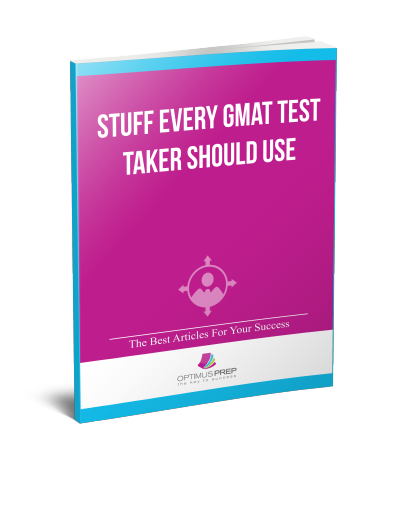
The Official Guide Books (OG)
There are three:
(1) The Official Guide for GMAT Review (all sections covered; ~900 questions; USD 46)
(2) The Official Guide for GMAT Quantitative Review (math only; 300 questions; USD 20)
(3) The Official Guide for GMAT Verbal Review (verbal only; 300 questions; USD 20)
Everyone should be using these books. Everyone. (Well, okay, everyone who is studying for the GMAT!) The questions printed in these books are real past GMAT questions, and nothing is better than the real thing.
Note that, while you do want to use the OG books, you will need more than this. The questions themselves are fantastic, but these materials do not teach you how to get better at taking the GMAT.
Initially, you’ll want to try some questions from these books one at a time, just to get used to the various question types and content areas tested. As you learn more, you’ll start to put together small sets of questions in order to practice timing. Eventually, you’ll be doing sets of 10 to 15 mixed questions, chosen randomly, under timed conditions. (Follow the link to learn more about how to do so on your own; you can also use the online access that comes with these books to give yourself random sets of questions.)
As of this writing, the three available versions are the 2015 editions, but the 2016 editions are due to hit bookshelves on June 1st. If you’ve already got your plans made and you want to take the test relatively soon, don’t delay your studies; just buy the 2015 editions and get going. If you’re not planning to start studying till the summer, though, then you might as well wait until June to buy the new editions.
GMATPrep Software (free)
Parts of this resource are free; there are also additional paid add-ons. Everyone should download the free software, which will give you access to two free practice CATS (exams) and 90 free practice questions (15 each in the six question categories: IR, PS, DS, SC, CR, RC). The practice questions include explanations; the test questions do not.
Again, these are all real past test questions, and the algorithm used on the practice tests is the same as on the real tests—and you want to study from the real thing. The two practice CATs do give you some data to analyze, but it’s not much. (It’s the same data you’ll get on the Enhanced Score Report, discussed later in this article.)
I generally tell my students to start with our tests (which provide extensive data, allowing you to analyze your strengths and weaknesses and come up with a study plan) and save the GMATPrep tests for later in your studies, when you’re just trying to gauge your current scoring levels to see whether you’re ready to take the real thing.
In addition, if you’re still struggling with timing, figure out a way to time yourself per question when taking a GMATPrep CAT. Most smartphones nowadays have a Stopwatch feature. Start the stopwatch and then hit the Lap button every time you finish a question. (On my iPhone, the Reset button turns into the Lap button once you start the timer.) When you’re done with the section, you’ll have a list of times per question.
The individual practice problems (that are not part of the CATs) are mostly on the easier side, so they’re good to use earlier in your studies as a way to learn about these question types and to see how they’re going to be presented on screen during the real test.
You may or may not decide to use the paid resources within GMATPrep; I’ll talk more about these in the next section.
Stuff you may decide to use
GMAT Focus (USD 30 for single use)
This is my favorite of the “may use” resources. GMAT Focus is a quant-only tool; I just wish they had something similar for verbal.
This tool allows you to do a set of 24 questions (12 PS, 12 DS), but here’s the best part: the questions are chosen adaptively, just as they are on the real test. In other words, you get adaptive practice (like the real thing!) without having to take a full-length practice test. (And the questions do not overlap with GMATPrep or OG.)
In addition, the test will record how much time you spend on each question and give you that data afterwards, along with explanations for those questions and an overall score range. (Think something along the lines of: you scored 47 to 51! You don’t get an exact score because it’s not actually a full test.)
This resource is hugely valuable for anyone struggling on the quant side of the test, particularly if you’re having timing issues with larger sets of questions. Putting together a non-adaptive set of 24 questions is just not going to provide you with the same kind of time pressures you’ll experience in an adaptive setting.
I have my students use these between practice CATs to see how their quant performance is coming along. For instance, we might diagnose a timing problem on a CAT and I’ll set up drills and activities for the student to do in order to improve. After 10 days to 2 weeks, we’ll try a GMAT Focus to see how it’s going. If everything’s coming together, maybe the student does another week’s worth of study before taking the next CAT. If things are still a struggle, perhaps the student needs another 2 to 3 weeks of work before taking the next CAT.
GMATPrep software (paid)
Two useful resources can be added to the free GMATPrep program for a fee. First up, you can purchase two additional practice tests (USD 50) via Exam Pack 1. These tests will look pretty much like the two free tests (with different questions of course), including the data available afterwards.
You can also purchase Question Pack 1 (USD 30), which is exactly what it sounds like: a pack of additional practice problems. (Note: if you get the three OG books, then you’ll already have access to about 1,500 practice problems, likely enough for most testers.)
If you find you need more, though, then the Question Pack is the way to go. It contains 200 quant, 180 verbal, and 24 IR questions. These questions do not overlap with the GMATPrep test questions or with OG. I recommend using the software as it’s designed: to set up random sets of questions for yourself later in your studies.
GMAT Enhanced Score Report
In January of this year, GMAC released the Enhanced Score Report, a report that you can order (for USD 25) after you take the real test to learn more about your specific strengths and weaknesses when taking the exam.
If you have already taken the real test and are planning to take it again, then this report may be valuable for you; take a look at the article linked in the previous paragraph for more information. The basic summary: the data is useful but limited, so not everyone will want to spend $25 for it. (Note: GMAC is considering adding more data to this report in future; if so, then depending on the nature of the new data, this report could become more important.)
IR Prep Tool
Right now, most people aren’t too concerned about their IR scores, but that could change in future as schools start to weight these scores more heavily in the decision-making process. If so, then you may want to look into GMAC’s IR Prep Tool (USD 20).
I looked at an early version of this when it was first launched but haven’t used it since. (Mostly because, again, IR just isn’t all that important right now.) As such, I don’t have any great recommendations about how to use this resource.
GMAT Write
We actually buy access to this program for all of our class students. GMAT Write (USD 30) is a great little program for the essay section of the test. You’ll write an essay under official conditions and then the real e-rater software that grades the official test essays will grade your GMAT Write essay. You’ll get a score and recommendations as to how you could improve that score. Then, you can re-write your essay and re-submit it to see whether you do get a better score.
Then you can do that all over again for a second essay topic. If you’re worried about hitting a 4.5 or higher on the essay, this is a great way to see what your current scoring level is, which will tell you whether you’re okay or whether you need to devote some time and energy to the essay.
The Official Guide for GMAT Review Mobile App
This product had completely escaped my attention until I visited GMAC’s store to make sure that I had the full product list represented here. I’ve never used the Mobile App (USD 5) myself, so what I’m about to tell you is just from the description I read on the mba.com website.
First, the name of this product and the screen shot shown on the web page lead me to believe that you’re basically buying access to the main OG title mentioned earlier (book #1).
It contains “50 GMAT exam questions, evenly distributed by type” (presumably 10 each of DS, PS, SC, CR, and RC). It also has 4 IR questions. You can also buy a “Power Pack” upgrade for USD 30; this upgrade contains “more than 800” questions across all types, including IR. This adds up to about the number of questions contained in the main OG.
My guess is that this is more of an “entry” product to allow people to see the quality of the material for a low price (the initial $5 for 54 problems) in order to convince them to buy other material. But you’re already going to buy other official material, including the main OG title! So you probably don’t need this.
GMAT Paper Tests
GMAC also sells old tests from the paper-and-pencil era (set of 3 for USD 30). The last paper-and-pencil test was given in June of 1997—that’s right, nearly 20 years ago. (Are you impressed that I knew that random stat? I didn’t even have to look it up. That was the very first time that I took the GMAT!)
I’ll tell you about these, but I wouldn’t recommend buying them (I’m not even going to link to them!). First, the GMAT is not given in this format any longer, so it’s useless to take these as practice tests. Second, the questions were all written a very long time ago; standardized tests do evolve over time. Third, there are many more recently written questions available, so just use those.
Quality vs. Quantity
As you decide which resources to use (and use them!), remember that your success is going to depend on a combination of quality vs. quantity study. Obviously, you have to study more than a few questions. At the same time, if you try to complete thousands of questions in a couple of months, all you’ll be doing is plowing through a bunch of questions—but not really learning much from them.
Good luck and happy studying!

